Two months of torrential downpours, atmospheric rivers and snowstorms have doused California with much-needed rainfall. Now, reservoirs across the drought-prone state are filling with rainfall, and many are nearing or exceeding historic levels, according to data first reported by the San Francisco Chronicle.
California is home to a massive system of water reservoirs, which provide roughly 60% of the state’s total water supply in a given year. The other share comes from groundwater.
Winter is a particularly important time for these water reservoirs, as the higher levels of precipitation seen between November and March serve as a buffer for the state’s traditionally dry summer months.
Many reservoirs across the state have surpassed their average storage capacities, a phenomenon that is primarily affecting reservoirs in California’s Central Valley. Oroville, for example, is one of California’s largest water reservoirs and is currently holding more water than its historic average for this time of year.
Now, half of California is drought-free due to the rainfall and snow, the Associated Press reports. Snowpacks in the Sierra Nevada region provide roughly one-third of the state’s water supply, and these snowpacks are more than 160% of the historical average on April 1.
Climate experts caution that the recent snowfall, precipitation and filling water reservoirs may not result in the end of California’s decadeslong mega-drought.
Check out these photos to see how water reservoirs look before and after this winter’s historic precipitation.
